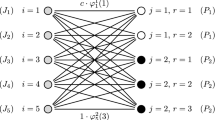The problem of scheduling N jobs on M uniform parallel machines is studied. The objective is to minimize the mean tardiness or the weighted sum of tardiness with weights based on jobs, on periods or both. For the mean tardiness criteria in the preemptive case, this problem is NP-hard but good solutions can be calculated with a transportation problem algorithm. In the nonpreemptive case the problem is therefore NP-hard, except for the cases with equal job processing times or with job due dates equal to job processing times. No dominant heuristic is known in the general nonpreemptive case. The author has developed a heuristic to solve the nonpreemptive scheduling problem with unrelated job processing times. Initially, the algorithm calculates a basic solution. Next, it considers the interchanges of job subsets to equal processing time sum interchanging resources (i.e. a machine for a given period). This paper models the scheduling problem. It presents the heuristic and its result quality, solving 576 problems for 18 problem sizes. An application of school timetable scheduling illustrates the use of this heuristic.
Similar content being viewed by others
References
Barnes, J. W. and Brennan, J. J. (1977) An improved algorithm for scheduling jobs on identical machines. AIIE Transactions, 9, 25–31.
Carrier, J. and Chretienne, P. (1988) Problèmes d'ordonnancement, modélisation, complexité, algorithmes, Masson Editor, ERI Collection, Paris.
Dogramaci, A. (1984) Production scheduling of independent jobs on parallel identical processors. International Journal of Production Research, 22, 535–548.
Dogramaci, A. and Surkis, J. (1979) Evaluation of a heuristic for scheduling independent jobs on parallel identical processors. Management Science, 25, 1208–1216.
Dreyfus, G. (1987) Chaos et C.A.O. ou la méthode du recruit simulé. AFCET/Interfaces, 53, 4–9.
Echalier, F. P. (1991) Problèmes d'ordannancement sur machines paralleles: apport du recuit simulé. Ph.D. Thesis, Lyon l University, France.
Elmaghraby, S. E. and Park, S. H. (1974) Scheduling jobs on a number of identical machines. AIIE Transactions, 6, 1–13.
Guinet, A. (1991) Textile production systems: a succession of non-identical parallel processor shops. Journal of Operational Research Society, 42, 655–671.
Kirkpatrick, S., Gelatt, C. D. and Vecchi, M. P. (1983) Optimization by simulated annealing. Science, 220, 671–680.
Lawler, E. L., Luby, M. G. and Vazirani, V. V. (1982) Scheduling open shops with parallel machines. Operations Research Letters, 1, 161–164.
Sarin, C. S. (1982) Scheduling independent projects against a single resource. International Journal of Production Research, 20, 135–146.
Tremoliere, R. (1978) Scheduling jobs of equal durations with tardiness costs and resource limitations. Journal of Operational Research Society, 29, 229–233.
Author information
Authors and Affiliations
Rights and permissions
About this article
Cite this article
Guinet, A. Scheduling independent jobs on uniform parallel machines to minimize tardiness criteria. J Intell Manuf 6, 95–103 (1995). https://doi.org/10.1007/BF00123681
Issue Date:
DOI: https://doi.org/10.1007/BF00123681




